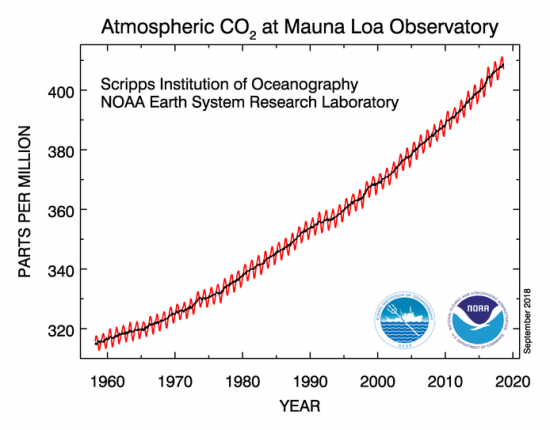Global Climate Action Series: Cisco Announces Ambitious Product Power Efficiency Goal

As published on Cisco's Corporate Social Responsibility Blog
This blog was guest written by Darrel Stickler, Global Environmental Sustainability Lead, Cisco.
Today is the first day of the Global Climate Action Summit (GCAS) in San Francisco, just north of Cisco’s global headquarters. A low-carbon footprint event for Cisco to attend! The theme of the summit is “Take Ambition to the Next Level.”
The summit is an opportunity to step back and look at the big picture—the greenhouse gas (GHG) concentrations in the Earth’s atmosphere. In the figure above, data from Mauna Loa Observatory in Hawaii suggests that we all have much more work to do. Every individual, organization, company, and country have an obligation to address this urgent, global problem.
Cisco categorizes our GHG and energy initiatives into four areas: operations, extended operations (supply chain), products, and the solutions we sell to our customers. More than a decade ago, Cisco used the IPCC 4th Assessment to set our initial operations GHG reduction goal, and we continue to follow that roadmap.
You read previously about our ongoing efforts to reduce GHG emissions and improve energy efficiency in our operations. As of FY2017, our GHG emissions are down more than 40% in absolute terms since 2008—ahead of the IPCC timeline—in spite of our business growing significantly over this time span.
Cisco provides information technology products, software, and services that support the creation of tremendous social and economic value. However, our hardware plugs into the wall and uses electricity, which has a carbon footprint. Because our products are powered by electricity, we’ve consistently identified greenhouse gas emissions as our most material environmental issue.
Cisco previously announced greenhouse gas reduction goals for our operations in 2008, 2013, and 2017. We’ve also set goals for our supply chain partners to take action.
Today, we are announcing a product power efficiency goal: improve large rack-mounted-equipment system power efficiency—as measured from the input power from the facility to the board-mounted ASICs, memory and other chip devices—from 77% to 87% by 2022 using an FY2016 baseline. It sounds complicated, so let’s unpack it a little.
“Cisco networking technology is transforming our global economy, creating new products and services, and raising living standards across developed and emerging markets. With more Internet users, more network connections, and increasing network traffic, we want our products to use electricity wisely. Our new product energy efficiency goal sets a benchmark for efficiency in our industry and demonstrates how innovation can drive both economic growth and environmental sustainability.”
— Marco Croci, SVP, Hardware Engineering, Cisco Systems
First, the goal focuses on “large rack-mounted equipment,” as that is what is used in energy-intensive enterprise and cloud data centers.
Next, let’s understand “system power efficiency.” Electrons have a complicated journey from the generation source to our equipment, along which energy is lost. Some losses occur in the utility grid and then there are more losses from the power pole outside the data center to the electrical sockets where our products plug in.
Inside our products, each electron continues its journey through a power supply that converts AC to DC (or higher voltage DC from the facility to lower voltage DC), and then through printed-circuit board traces and additional voltage conversion until finally, the electrons power our chips for network processing, memory for data storage, and interconnects where network traffic is sent to the next node in the network.
The “efficiency” in our goal is the ratio of electricity used by this point-of-load to what entered through the plug. We’ve already been working over the last decade to improve product efficiency from a point less than 60%, and this goal is to increase efficiency to 87% using innovative power-delivery techniques and advanced power switching devices.
Cisco is addressing GHG emissions in our operations, supply chain, and products. All companies, organizations, and countries worldwide need to step up to meet this global challenge. The summit in San Francisco this week is a chance to take stock and take our collective ambition to the next level.
Let me know what you think in the comments below. Please check on our progress against all our goals in our next CSR Report to be published in early December 2018.

